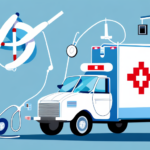Starting a Medical Supply Transport Business
If you are considering launching a medical supply transport business, you are stepping into a vital and expanding sector that plays a crucial role in supporting healthcare facilities and patient care. Establishing any business demands meticulous planning and research, and the medical supply transport industry is no different. This guide delves into the essential aspects you need to address to build a thriving medical supply transport business.
Understanding the Medical Supply Transport Industry
The medical supply transport industry is responsible for the efficient and secure movement of medical and healthcare-related products, including pharmaceuticals, medical equipment, laboratory specimens, and patient records. This industry is integral to healthcare systems, ensuring that facilities are well-stocked and equipped to provide essential services to patients.
According to a report by IBISWorld, the medical supply wholesale industry has seen steady growth, driven by the increasing demand for healthcare services and advancements in medical technology. However, transporting these supplies presents unique challenges, such as the need for temperature-controlled environments and compliance with stringent regulatory standards.
Key Challenges
- Specialized Handling: Certain medical supplies require specific conditions, such as refrigeration, to maintain their efficacy.
- Regulatory Compliance: Adhering to regulations related to safety, quality, and privacy is paramount to avoid penalties and maintain client trust.
- Logistical Efficiency: Ensuring timely deliveries while managing costs and maintaining the integrity of the supplies.
Identifying Your Target Market and Demographics
Defining your target market is a critical step in establishing a successful medical supply transport business. Your primary clients will typically include hospitals, clinics, nursing homes, and other healthcare facilities. Additionally, there is a growing market for home healthcare services, catering to patients who require medical supplies delivered directly to their residences.
Market Research
Conduct comprehensive market research to understand the specific needs of healthcare providers in your region. Analyze factors such as:
- The types of medical supplies most frequently transported.
- The volume and frequency of deliveries required.
- Geographical areas with high demand for medical transport services.
Utilize data from sources like the Centers for Disease Control and Prevention (CDC) and HealthIT.gov to inform your market analysis and identify emerging trends in healthcare demands.
Researching Your Competitors and Differentiating Yourself
Understanding the competitive landscape is essential for positioning your business effectively. Identify existing transport companies in your area, analyze their service offerings, pricing structures, and customer reviews to identify gaps and opportunities.
Strategies for Differentiation
- Exceptional Customer Service: Provide personalized attention, prompt responses, and reliable support to build strong client relationships.
- Advanced Technology: Implement tracking systems and automated notifications to enhance transparency and reliability.
- Sustainability Practices: Adopt eco-friendly transportation methods and sustainable business practices to appeal to environmentally conscious clients.
According to a study by Harvard Business Review, businesses that focus on customer-centric strategies and sustainability can achieve a competitive edge and foster long-term loyalty.
Creating a Business Plan and Securing Funding
A comprehensive business plan is the foundation of your medical supply transport business. It should outline your services, target market, marketing strategies, operational procedures, and financial projections. A well-structured business plan not only guides your business decisions but also attracts potential investors and lenders.
Components of a Business Plan
- Executive Summary: Overview of your business goals and strategies.
- Market Analysis: Insights into industry trends, target market, and competitor analysis.
- Operational Plan: Details on logistics, vehicle management, and staffing.
- Financial Projections: Revenue forecasts, expense estimates, and break-even analysis.
Securing Funding
Funding your business can be achieved through various avenues, including:
- Traditional Bank Loans: Suitable for businesses with solid credit and collateral.
- Crowdfunding: Platforms like Kickstarter and Indiegogo can help raise capital from a broad audience.
- Angel Investors and Venture Capitalists: Ideal for businesses with high growth potential and innovative approaches.
Consider consulting resources such as the Small Business Administration (SBA) for guidance on funding options and financial planning.
Legal Requirements and Compliance
Operating a medical supply transport business entails adhering to numerous legal and regulatory requirements to ensure safety, quality, and confidentiality.
Licenses and Permits
- Business License: Register your business with the appropriate state and local authorities.
- Commercial Driver’s License (CDL): Required for drivers operating commercial vehicles.
- Special Permits: Necessary for transporting controlled substances or hazardous materials.
Refer to the Federal Motor Carrier Safety Administration (FMCSA) for detailed information on required licenses and permits.
Regulatory Compliance
- HIPAA Compliance: Ensure the protection of patient information during transportation. Implement data security measures and train staff on confidentiality protocols.
- Vehicle Safety Standards: Maintain vehicles to meet safety regulations, including regular inspections and necessary certifications.
Compliance with the Health Insurance Portability and Accountability Act (HIPAA) is non-negotiable and critical for maintaining trust and avoiding legal repercussions.
Operations and Logistics
Efficient operations and logistics are the backbone of a successful medical supply transport business. This encompasses vehicle selection, route planning, inventory management, and staff training.
Selecting the Right Vehicles
- Temperature-Controlled Vehicles: Necessary for transporting perishable medical supplies like vaccines and blood products.
- Size and Capacity: Choose vehicles that can accommodate the volume and type of supplies you are transporting.
- Fuel Efficiency: Opt for vehicles that offer a balance between capacity and fuel economy to manage operational costs effectively.
According to the U.S. Department of Energy, investing in fuel-efficient vehicles can significantly reduce long-term operational expenses and environmental impact.
Hiring and Training Staff
- Qualified Drivers: Employ drivers with the necessary licenses, clean driving records, and experience in handling medical supplies.
- Comprehensive Training: Provide training on handling sensitive materials, emergency procedures, and compliance with regulations.
Implementing Safety Measures
- Safety Protocols: Develop and enforce protocols to ensure the safe handling and transportation of medical supplies.
- Regular Maintenance: Schedule routine vehicle maintenance to prevent breakdowns and ensure the safety of transported goods.
Adopting robust safety measures not only protects your inventory but also safeguards your employees and enhances your company’s reputation.
Developing a Marketing Strategy
Effective marketing is essential to attract and retain clients in the competitive medical supply transport industry. A well-rounded marketing strategy should leverage both traditional and digital channels to reach your target audience.
Digital Marketing
- Search Engine Optimization (SEO): Optimize your website with relevant keywords to improve visibility on search engines. Focus on terms like “medical supply transport” and “healthcare logistics services”.
- Social Media Marketing: Utilize platforms like LinkedIn and Facebook to connect with healthcare professionals and showcase your services.
- Email Marketing: Send targeted emails to potential clients with updates, offers, and informative content about your services.
Traditional Marketing
- Networking: Attend industry conferences, trade shows, and local business events to build relationships with healthcare providers.
- Print Advertising: Advertise in healthcare journals, local newspapers, and industry magazines to reach a broader audience.
- Referrals: Encourage satisfied clients to refer your services to other healthcare facilities.
Unique Selling Proposition (USP)
Identify what sets your business apart from competitors. Your USP could be rapid delivery times, advanced tracking systems, specialized handling of sensitive supplies, or exceptional customer service.
According to Forbes, businesses with a clear USP are more likely to attract and retain customers by clearly communicating their unique benefits.
Establishing Relationships with Healthcare Facilities
Building strong relationships with healthcare facilities is paramount for securing consistent business and long-term contracts. Focus on demonstrating reliability, flexibility, and a deep understanding of their specific needs.
Strategies for Relationship Building
- Personalized Service: Tailor your services to meet the unique requirements of each facility, offering customized solutions where possible.
- Consistent Communication: Maintain regular contact with clients through updates, feedback requests, and proactive problem-solving.
- Value-Added Services: Offer additional services such as inventory management, emergency deliveries, or real-time tracking to enhance your value proposition.
According to research by NCBI, strong client relationships lead to higher customer satisfaction and increased loyalty, which are critical for business growth.
Building a Strong Reputation in the Industry
A solid reputation is essential for attracting new clients and sustaining your business in the competitive medical supply transport industry. Focus on providing high-quality services, maintaining compliance, and ensuring customer satisfaction to build and uphold your reputation.
Quality Assurance
- Reliable Deliveries: Ensure timely and accurate deliveries to build trust with your clients.
- Compliance: Adhere strictly to all regulatory standards and industry best practices.
Customer Feedback
Solicit feedback from your clients to identify areas for improvement and demonstrate your commitment to excellence. Implementing feedback can lead to service enhancements that reinforce your reputation.
According to a survey by Pew Research Center, businesses that actively seek and incorporate customer feedback are better positioned to meet client needs and achieve higher satisfaction rates.
Expanding Your Business and Meeting Growing Demand
As your medical supply transport business grows, it is essential to scale your operations to meet increasing demand without compromising on service quality. Strategic planning and investment in resources will support sustainable growth.
Investing in Technology
- Fleet Management Systems: Utilize software to optimize vehicle routes, monitor driver performance, and manage maintenance schedules.
- Inventory Management: Implement systems to track inventory levels, manage stock, and predict demand trends.
Scaling Operations
- Fleet Expansion: Invest in additional vehicles to increase your transport capacity.
- Staffing: Hire more drivers and support staff to handle increased workloads and maintain service standards.
Exploring New Markets
Consider expanding your services to new geographical areas or diversifying into related sectors, such as pharmaceutical distribution or medical waste management, to broaden your business opportunities.
According to the Statista, the global medical transportation market is projected to grow significantly in the coming years, presenting ample opportunities for expansion.
Challenges and Opportunities for Medical Supply Transport Businesses in the Future
The medical supply transport industry is continually evolving, presenting both challenges and opportunities for businesses. Staying informed and adaptable is key to navigating this dynamic landscape.
Future Challenges
- Increased Competition: As the industry grows, more players enter the market, intensifying competition.
- Regulatory Changes: Evolving regulations require businesses to stay updated and compliant.
- Technological Advancements: Keeping up with rapid technological changes can be resource-intensive.
Emerging Opportunities
- Technological Integration: Leveraging advanced technologies like AI and IoT for enhanced logistics and tracking.
- Value-Added Services: Offering specialized services such as temperature-controlled transport or emergency response services.
- Sustainability Initiatives: Implementing eco-friendly practices to attract environmentally conscious clients.
Embracing innovation and maintaining flexibility will enable your business to capitalize on emerging opportunities and mitigate potential challenges.
Conclusion
Launching a medical supply transport business requires thorough planning, a deep understanding of the industry, and a commitment to excellence. By addressing the key areas outlined in this guide—understanding the industry, defining your market, differentiating your services, ensuring legal compliance, optimizing operations, developing effective marketing strategies, building strong relationships, maintaining a stellar reputation, and planning for growth—you can establish a successful and sustainable medical supply transport business that significantly contributes to the healthcare sector.




















